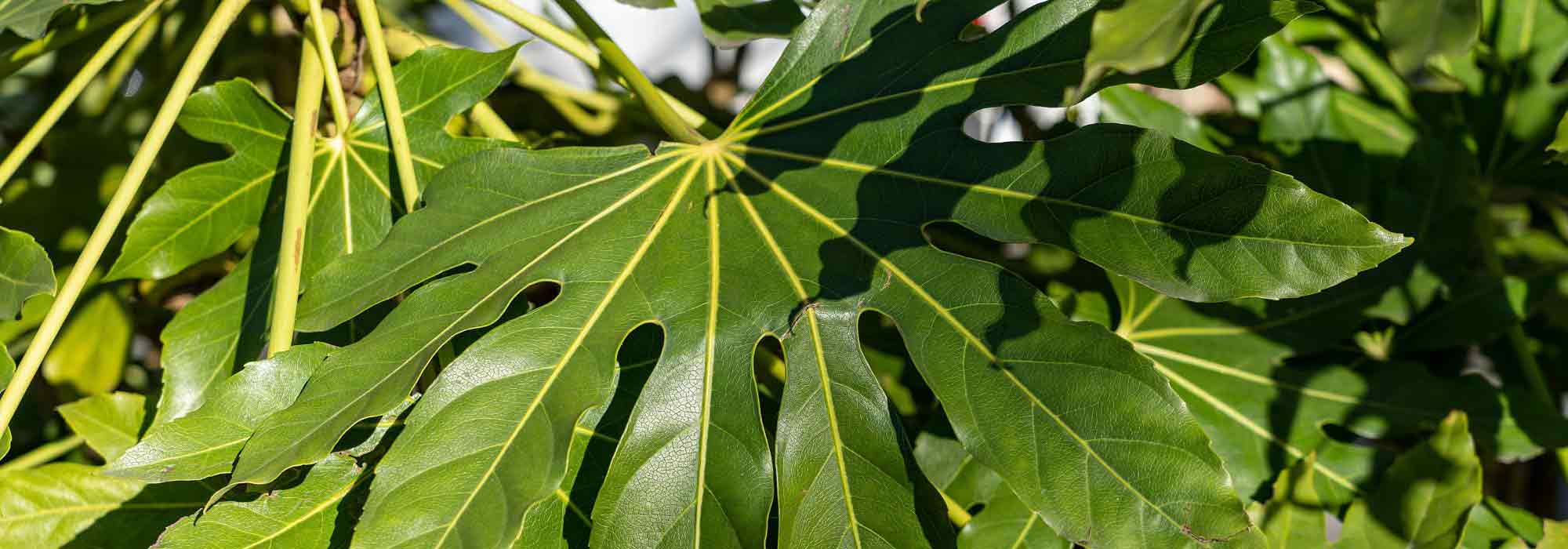
Fatsia japonica, False Aralia: planting, growing, and care
Contents
Fatsia in a nutshell
- The Fatsia is a decorative bush with an exotic look.
- Its lush, evergreen foliage is green or variegated with white.
- It can be used as an indoor plant or planted directly in the ground.
- Hardy down to around -12°C, it thrives in sheltered, partially shaded spots.
- It prefers slightly acidic, moist soil.
- Its autumn flowering in white umbels is followed by black berries.
- Disease-resistant and low-maintenance, it’s an easy plant to grow.
The word from our expert
The Fatsia, or False Aralia, is a decorative bush that, after adorning our interiors, has now found a prime spot in our gardens, thanks to its hardiness, which allows it to withstand temperatures as low as -12°C. Its large evergreen leaves, lobed and glossy, which come in vibrant green, variegated, or speckled with white, give it a lush and exotic appearance. Standing between 1.20 m and nearly 3 m tall, depending on whether it is grown in a pot or in the ground, this bush with a rather rounded habit flowers from late summer to autumn, with umbels of whitish flowers reminiscent of ivy. Later in the season, small, round, black, and glossy berries follow this flowering. Sensitive to scorching sun as well as cold winter winds, both of which damage its foliage, the Fatsia thrives in sheltered and partially shaded spots, in fresh but well-drained soil, preferably rich and low in lime. With relatively slow growth, it requires very minimal maintenance.
Used in light woodland, in beds under trees, or in pots on patios or terraces, it is an easy and essential plant for creating a tropical or Japanese-inspired atmosphere.
Description and Botany
Botanical data
- Latin name Fatsia japonica, Fatsia polycarpa
- Family Araliaceae
- Common name Japanese Fatsia, False Aralia
- Flowering autumn
- Height 1.5 m to 3m in all directions
- Exposure partial shade, light shade, sheltered
- Soil type slightly calcareous, fresh, well-drained, rich and light
- Hardiness -12°C to -15°C
The Fatsia is a decorative bush (sometimes considered a giant perennial) from the Araliaceae family, like the common Ivy or the Schefflera. There are very few species, including Fatsia oligocarpella, Fatsia polycarpa and Fatsia japonica, the latter being the most widespread and commonly used in gardens. Also known as Japanese Fatsia, Japanese Aralia, or False Aralia, it originates from Japan, Korea, and Taiwan. It is sometimes encountered under other botanical names, such as Fatsia sieboldii or Aralia sieboldii, but should not be confused with the Aralia, a bush from the same family but representing a distinct genus.
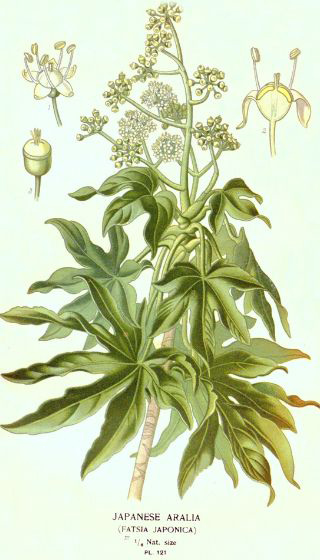
Fatsia japonica: botanical illustration (Wikimedia commons)
For a long time confined to our interiors and used solely as a houseplant, it has proven hardier than initially thought and has gradually migrated to gardens with mild to moderately harsh winters. Its hardiness allows it to tolerate temperatures as low as -10 to -15°C, depending on growing conditions. However, the tender young leaves, which develop in spring, can be damaged by late frosts.
An evergreen bush, it is highly prized for its exotic and tropical appearance. When grown in pots, it rarely exceeds 1.50 m but can reach over 3 m when planted in the ground. Its spread typically ranges between 1.20 m and 3 m on average.
The main attraction of the Fatsia is its foliage, which is palmatilobed, meaning deeply divided, usually into 7 to 9 lobes, with more or less dentate edges. Large in size, these leaves can measure over 30 centimetres in diameter. They are glossy and borne on thick, sturdy petioles. Light green and shiny for the species-type, they are darker and variegated with white in Fatsia japonica ‘Variegata’, or broadly splashed with cream in Fatsia japonica ‘Spider’s Web’. Also green, Fatsia polycarpa ‘Green Fingers’ (the Taiwanese Fatsia) features leaves divided like the fingers of a hand. The mature bush adopts a dense, upright habit, with a rather rounded crown.
The flowering of the Fatsia occurs between late summer and autumn. Nectariferous, it consists of umbels of very small off-white flowers, reminiscent of those produced by ivy, atop sturdy stems. These flowers later turn into decorative, round, black berries, which are toxic to humans.
With rather slow growth, the Fatsia thrives in woodland settings, sheltered patios, or when grown in pots on terraces spared from harsh winds and scorching sun.
A fresh, well-drained, light, and neutral to acidic soil provides the best conditions for its lush foliage to flourish.

The divided foliage and inflorescences of Fatsia japonica
Maintenance of the False Aralia is minimal, making it ideal for contemplative gardeners. Rarely affected by diseases, it may occasionally attract scale insects, spider mites, or whiteflies, but natural control methods are now available.
Species and varieties
There are few species used in the garden, but some varieties offer interesting and highly decorative shades of colour or shapes.
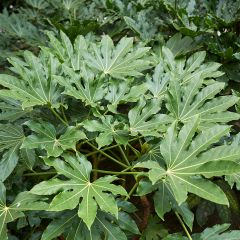
False Aralia - Fatsia japonica
- Flowering time October, November
- Height at maturity 2,50 m

Fatsia japonica Variegata
- Flowering time September to November
- Height at maturity 2 m
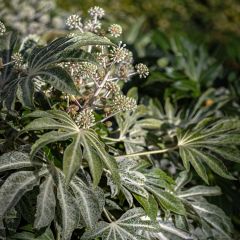
Fatsia japonica Spiders Web - Variegated False Aralia
- Flowering time August to October
- Height at maturity 2 m

Fatsia polycarpa Green Fingers
- Flowering time November, December
- Height at maturity 2 m
Discover other Fatsia
View all →Available in 2 sizes
Available in 3 sizes
Available in 2 sizes
Available in 2 sizes
Planting
Where to Plant
- Place your Fatsia in a neutral to acidic soil, which remains moist during the season but well-drained in winter, and preferably rich and light.
- Provide it with a sheltered spot, protected from both cold, strong winds and intense sunlight, both of which can scorch the foliage. Dappled light or light shade, such as that found at the edge of a forest, in woodland, or under the canopy of a tree, suits it perfectly. It also thrives very well under the protection of walls, such as those of a sheltered patio.
- When grown indoors, avoid locations that are too hot and dry, as well as direct sunlight behind a south-facing window. Generally, a bright, not overheated, and humid atmosphere ensures a healthy plant.
When to Plant
- Planting in the ground is ideally done in autumn in mild climates, or in spring in less temperate regions.
- For indoor use, planting can take place year-round.
How to Plant
In the Ground
- Soak the root ball in a large volume of water to saturate the substrate.
- Dig a hole 2 to 3 times the size of the root ball and loosen the soil you’ve removed.
- If necessary, lighten your soil with sand (which improves drainage) and compost. A layer of drainage (clay balls, gravel, etc.) enhances water drainage at the root level.
- Remove your Fatsia from its pot and place it in the centre, ensuring the top of the root ball is level with the soil surface.
- Fill in with the remaining substrate and firm lightly around the base.
- Water generously (a 10-litre bucket), then mulch with the material of your choice (grass clippings, dead leaves, wood chips, ready-to-use mulch, etc.).
- Monitor the substrate to ensure it doesn’t dry out, as the plant is more sensitive to drought in its early years.

Keep an eye on watering your Fatsia to give it the best chance to thrive
In a Pot
- Soak the root ball to moisten it.
- Choose a pot slightly larger than the one in which you purchased it.
- Ensure there is a drainage hole at the bottom of the pot and add a drainage layer a few centimetres deep, such as clay balls.
- Use a rich, light compost. Place a first layer, on which you position your bush, then fill in the gaps and firm lightly. Leave a few centimetres at the top of the pot to facilitate watering.
- Water in stages to saturate the entire substrate.
- Apply a mulch on top of the pot, which serves both a decorative role and reduces evaporation.
- Never let the compost dry out completely. In summer, you may need to water daily during heatwaves and drying winds. Space out watering more in winter, especially if the weather is rainy.
Tip: To create a more humid atmosphere, you can place the pot on a saucer filled with clay balls. Keeping them moist creates a microclimate favourable to the plant. Outdoors, remember to remove the saucer in winter or even raise the pot slightly.
Maintenance and Care
Outdoor Cultivation
The Fatsia is a bush that requires almost no maintenance. However, ensure the soil remains moist during the growing season. To this end, prefer a generous weekly watering over less frequent daily watering. In pots, you will need to intervene more often, as the soil dries out faster.
Its relative hardiness may require you to protect it with a winter fleece in case of intense and prolonged cold, which should be removed as soon as temperatures rise.
At the end of winter, simply prune the damaged stems and leaves, then add a layer of compost or an appropriate soil amendment at its base, before completing the mulching.
Once flowering is over, i.e., when the berries form, you can cut back the spent stems to concentrate the plant’s energy into developing its foliage.
→ Also read: Our tips for growing a Fatsia in a pot outdoors.

Indoor Cultivation
When grown indoors, the Fatsia can quickly suffer in environments that are too hot and dry. Water regularly throughout the year, but more frequently and generously in summer. Also mist its foliage to maintain the humidity it enjoys and to limit attacks from certain pests.
Between March and October, mix a liquid fertiliser into your watering water (following the recommended dosages) every two to three weeks.
When your Fatsia starts to outgrow its pot, repot it into a slightly larger container. If repotting is not possible, top-dress the plant. This involves scraping off a thin layer of the surface soil and replacing it with fresh compost. Remember to water immediately afterward.
→ Also read Fatsia japonica: our tips for growing and caring for this plant indoors.
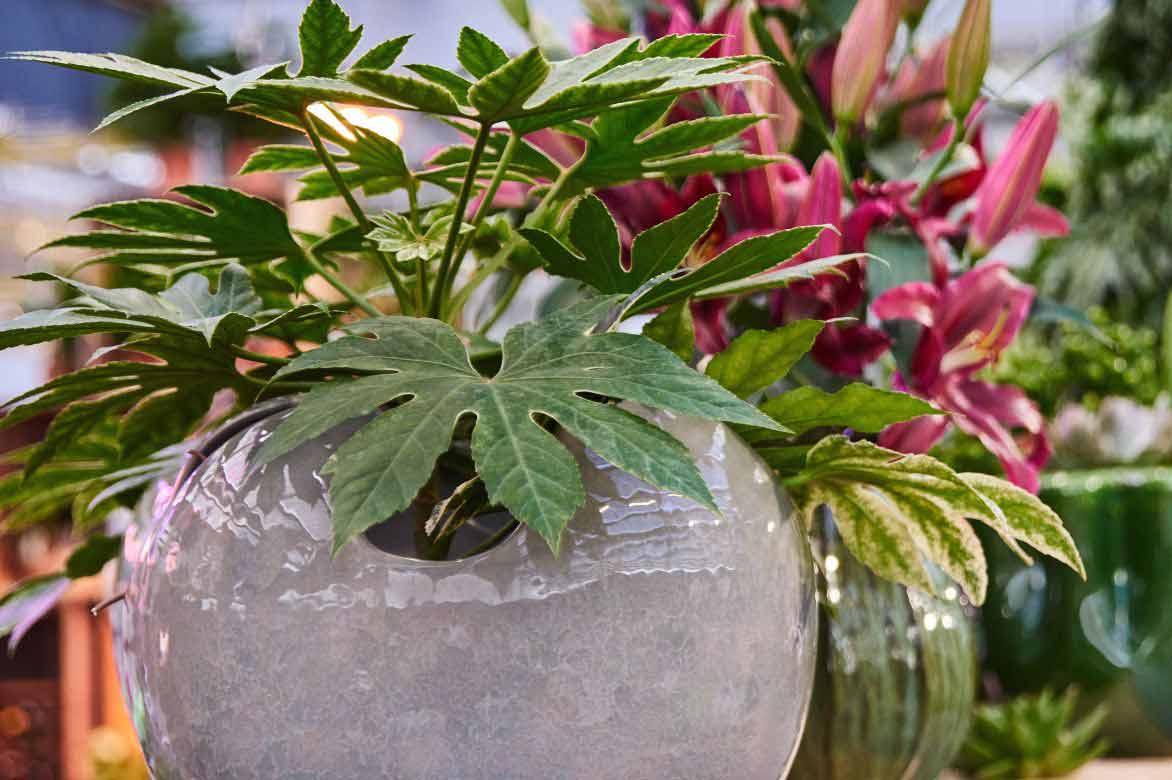
Pests
- The Fatsia can be targeted by scale insects, such as the Brown Scale, which attaches to the undersides of leaves as small brownish bumps. The simplest method is to remove them by hand or with a cotton swab dipped in alcohol and destroy them. Learn more about this pest in our advice sheet.
- Red spider mites, which are actually tiny mites, also thrive in environments that are too dry and hot. To learn how to identify and combat them, read our advice in this dedicated sheet.
- Aphids may also occasionally settle on the Fatsia. In this case, shower your plant with a strong, concentrated jet of water to dislodge them. Find all our tips for combating aphids in our special guide.
Finally, there are natural control methods to limit the spread of pests to your plant.
Multiplication
Propagation by cuttings and sowing both yield good results.
Propagation by Cuttings of Fatsia
- Between June and September, take semi-hardwood cuttings (their base has begun to lignify and their tip is still in growth and tender) about 15 centimetres long, cutting below a node (the part where the petiole is inserted on the main stem).
- Remove the leaves at the base to keep only 2 or 3 at the top. Cut the leaves at the top in half to also reduce evaporation.
- Insert your cuttings up to the upper leaves into a pot filled with light compost, such as special cutting compost.
- Keep your cuttings warm and in a bright spot but out of direct sunlight. To encourage a high-humidity environment, cover with a transparent plastic bag, ensuring it doesn’t touch the leaves.
- Plant in the ground or in pots the following spring.
Sowing Fatsia
- In November, collect the seeds from your bush.
- Sow them in small pots and cover with a thin layer of vermiculite.
- Place your buckets at a temperature of around 15 to 20 °C. Germination usually occurs within the next 15 days.
- When the plants have developed 2 true leaves, transplant them into individual pots and keep them under cover.
- You can plant your young plants in the ground the following spring, but an additional year of pot cultivation will produce stronger young plants.
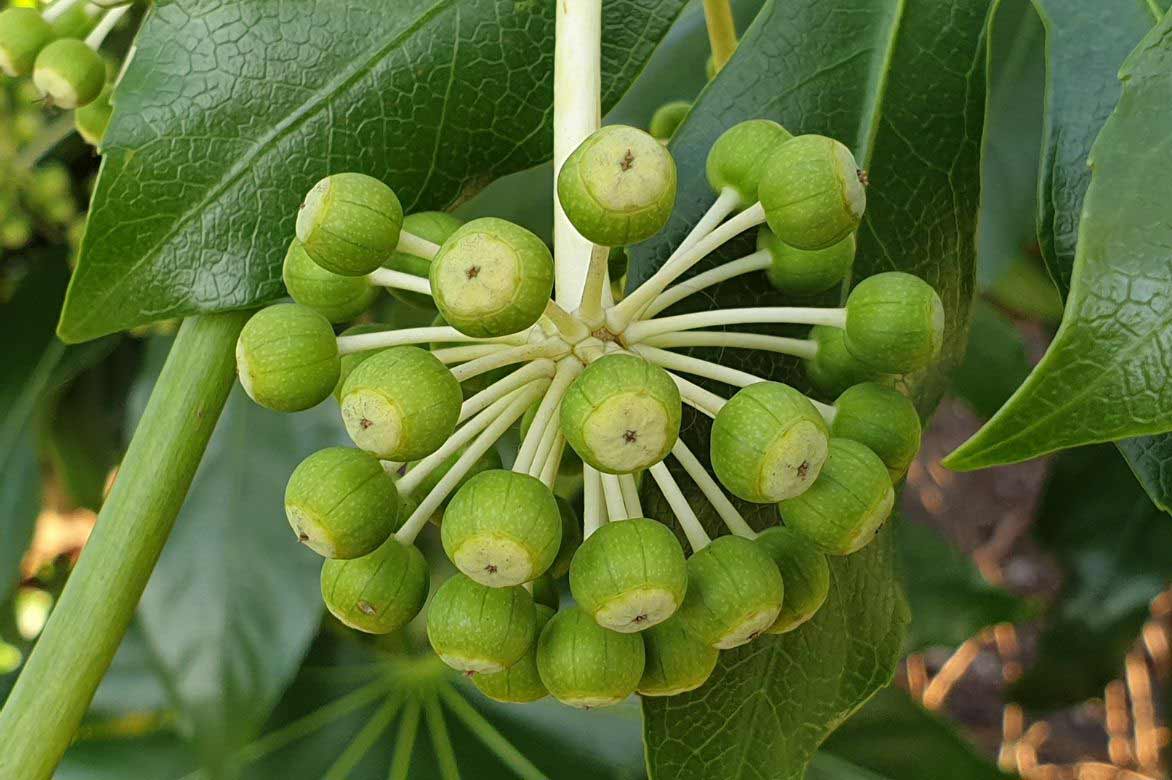
Fatsia japonica seeds before ripeness
Combining Fatsia in the Garden
The large leaves of the Fatsia give it an exotic look, perfect for creating lush tropical atmospheres. You can focus your composition on foliage, choosing plants renowned for the texture, shape, colour, or size of their leaves. For example, the common Aucuba (though not so common when paired with well-chosen companions). Like the False Aralia, the Schefflera is hardier than you might think, and its palmate, graphic foliage enhances the jungle effect. Another must-have is the Gunnera manicata, with its enormous leaves, and its cousin Gunnera magellanica, which forms a dense, low-growing ground cover. The Farfugium, with its round leaves—sometimes curled or speckled with yellow—and topped by autumn daisy-like yellow flowers, adds a unique touch. Other candidates to complete the picture include the Aspidistra (which has also migrated from our interiors to garden beds), the Colocasia with its broad, lance-shaped leaves—some varieties almost black-purple—the Darmera peltata, the Acanthus, the Rodgersia, the Chinese Windmill Palm, or the Japanese Banana.
And since we’re talking about Japan, why not enhance the atmosphere of a sunlit garden with plants like Bamboos (don’t worry, with species like the Fargesia, which stay in place, no root barrier is needed!), Japanese Maples (their spring foliage is often stunning, and they become irresistible when autumn paints them in vibrant colours), Camellias, and Azaleas and Rhododendrons, prized for their exceptional flowering.
Among low-growing perennials, consider the Hostas, whose beautiful foliage is complemented by delicate, sometimes fragrant flowers, the Bleeding Hearts with blooms that even Cupid would envy, or the Epimedium (or ‘Fairy Wings’). Finally, add low, soft-textured grasses like the Carex or the Hakonechloa, or gramineous perennials such as the Ophiopogon, and scatter a few bulbs here and there—some to brighten early spring, others to take over in summer or close the season in autumn.
→ Also discover 7 ideas for pairing Fatsia!
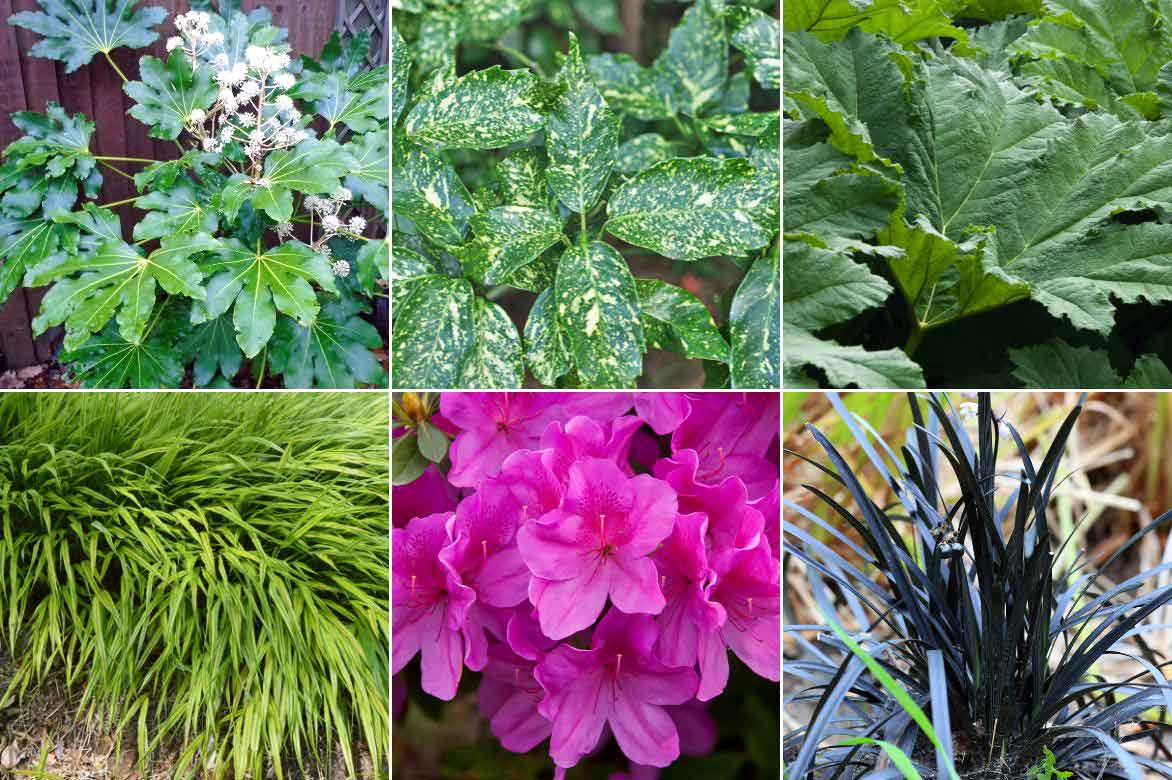
Fatsia japonica, Aucuba japonica, Gunnera manicata, Hakonechloa, Rhododendron, and Ophiopogon
Useful resources
- Discover our different varieties of Fatsia.
- To care for your bush, read: “Diseases and parasitic issues of Fatsia or Japanese Aralia“.
- All our tips for creating an exotic garden!
- Creating an exotic atmosphere on a balcony or terrace? Get inspired by our article.
- 10 must-have plants for a jungle-themed garden!
- All our tips for designing a Japanese or Zen garden.
Frequently asked questions
-
Why do leaves dry out and turn brown?
In summer, excessive heat can scorch the foliage. In this case, consider moving your plant to a shadier spot.
In winter, extreme cold, further intensified by wind, can also damage the foliage (young spring foliage is particularly sensitive to this). In this case, you can protect the plant with winter fleece (to be removed during milder spells), plant wind-filtering vegetation, or relocate your plant to a more sheltered area.
-
Can I prune my Fatsia?
Apart from tidying up the bush by removing old, damaged foliage, pruning is not essential, but the Fatsia tolerates this operation well if the plant becomes too large. It is best to carry this out in spring.
- Subscribe!
- Contents


































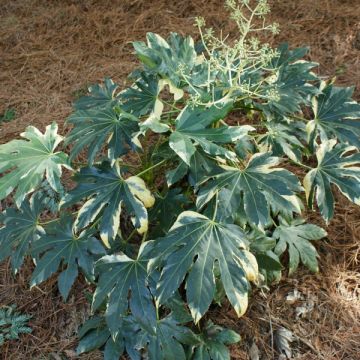
Comments